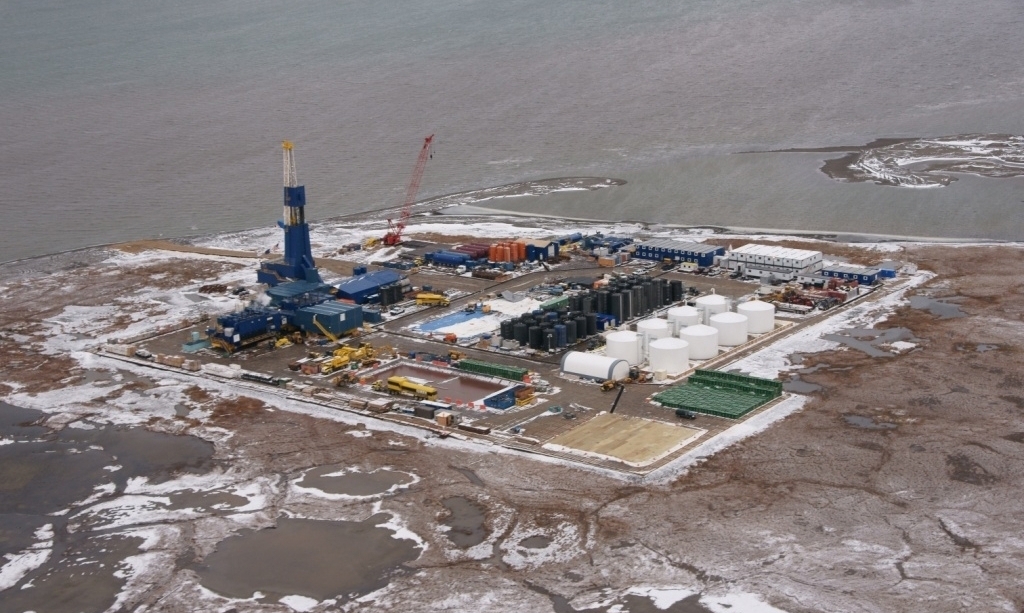Under settlement, ExxonMobil proposes more oil production at Point Thomson field

ExxonMobil is proposing a dramatic increase in oil production at a North Slope field, under the terms of a 2012 settlement with the state that ended a seven-year legal battle, according to a newly submitted development plan.
The oil giant has begun working on engineering studies and seeking regulatory approval to boost the light oil, or condensate, being produced at the Point Thomson field – to more than 50,000 barrels daily from its current capacity of up to 10,000 barrels.
But ExxonMobil and partners won’t make a final decision to approve the project until the end of 2019.
No expansion, however, and the oil giant could lose much of its acreage at the northeast Alaska field, at the doorstep of the Arctic National Wildlife Refuge.
The potential penalty is part of the settlement with Alaska that forced ExxonMobil into development, decades after it had become a unit in 1977. After nearly 30 years without oil or gas production, the state under Gov. Frank Murkowski in 2005 put the unit in default and later terminated the leases. Those steps launched the court battle that led to the agreement.
ExxonMobil has blamed the decades of delay on the field’s complexity. Remote Point Thomson is an extremely high-pressure reservoir, with the gas located more than two miles underground.
In a first step under the settlement, ExxonMobil built a $4 billion production system to produce and ship up to 10,000 barrels of light oil daily. Production launched there in April 2016, and that top rate was achieved on Dec. 20.
[Point Thomson sees its first oil production]
Production at that level hasn’t been sustained, said Chantal Walsh, director of the Alaska Division of Oil and Gas.
“They would like to produce the 10,000 but are struggling with mechanical issues,” Walsh said on Wednesday. “It’s a very technically challenging reservoir for anyone to produce.”
During the yearlong period ending in April, the field’s average production was 3,000 barrels of oil daily, according to figures from the Alaska Oil and Gas Conservation Commission.
ExxonMobil did not return phone calls and emails seeking comment for this article.

The company is working to overcome the field’s challenges, officials have said.
Additional development at the field is considered critical for Alaska’s $43 billion gas-export project, currently called Alaska LNG. Primarily a natural gas field, Point Thomson holds about one-fourth of the gas that would support the long-sought effort.
With the gas-export project not built, ExxonMobil has produced the gas for its condensate, or light oil. The gas has been injected back into the high-pressure reservoir using special compressors. The light oil has been extracted from the gas and shipped to the trans-Alaska pipeline.
[A visit to the Point Thomson field]
ExxonMobil, along with Point Thomson partner BP and ConocoPhillips, had a chance to complete the Alaska LNG project. But the oil companies backed out of the project last year over concerns that it wasn’t competitive, leaving the state as the lone sponsor for Alaska LNG.
ExxonMobil’s plan says it would prefer to use the Point Thomson gas for the gas-export project, one option under the settlement. But with the construction of that effort still uncertain, ExxonMobil is now looking to expand condensate production to meet the settlement terms.
ExxonMobil submitted the proposal, called a plan of development, to the Division of Oil and Gas on June 30.
In the plan, ExxonMobil’s also proposes to ship Point Thomson gas to the aging Prudhoe Bay oil field. It would build a 60-mile, 32-inch line to ship the gas to the field.
The gas would be injected into the Ivishak reservoir. The goal is boosting pressure in the Prudhoe Bay reservoir, helping squeeze more oil to the surface. The gas would be stored there until a gas-export project is built.
Mark Myers initially put ExxonMobil into default when he led the state’s Oil and Gas Division in 2005, after the company failed to submit a timely development plan.
On Wednesday, Myers, now retired from state employment, said he thought the plan proposed by ExxonMobil could become reality, if it receives the blessing of state regulators and ExxonMobil’s partners at Prudhoe Bay and Point Thomson.
“It’s very, very valuable, a large asset with lot of sunk costs,” Myers said. “I think ExxonMobil would be motivated to do it.”
Alaska oil field regulators will have to determine if shipping Point Thomson gas to Prudhoe Bay results in the maximum recovery of the state’s resources, Myers said.
If gas is not injected back into Point Thomson, reservoir pressure there will be reduced, potentially hurting future oil production.
Injecting the gas back into Point Thomson is costly, requiring a lot of compression, Myers said. That may explain why ExxonMobil is proposing to move gas to Prudhoe Bay, rather than injecting it back into Point Thomson. ExxonMobil’s plan says it would use already-built compression facilities to inject the gas into the Prudhoe Bay reservoir.
“The question is whether that’s in the state’s best interest,” Myers said.
Walsh, the current oil and gas director, said the division is reviewing the plan and must reply by late August.